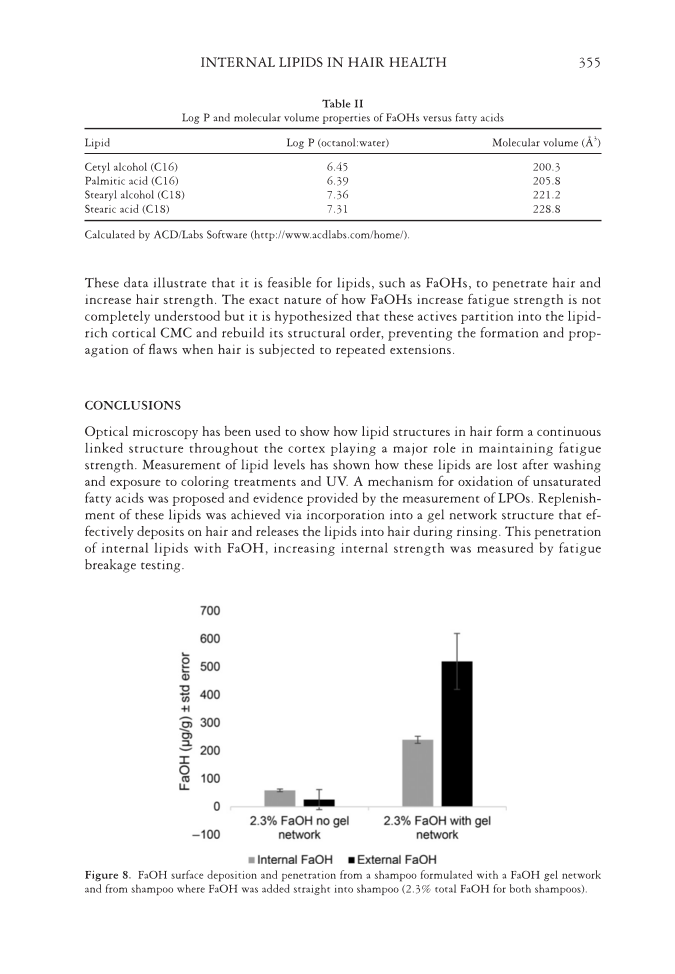JOURNAL OF COSMETIC SCIENCE 354 lipids an initial extraction with hexane-quantifi ed external FaOHs and a second ex- traction with chloroform:methanol–quantifi ed internal lipids. Figure 8 illustrates the importance of gel network to aid FaOH penetration comparing equal FaOH levels in a shampoo either added straight into the shampoo or as part of a gel network. Very low levels penetrated from the product with FaOH just added, but substantial penetration is measured from the gel network containing product. Table III shows fatigue data when hair treated with an ammonia/hydrogen peroxide oxidant system was washed 16 cycles in the same gel network shampoo versus an identical shampoo with no added gel network. The alpha value shown is obtained from the Weibell distribution function and is the characteristic lifetime when 63.2% of fi bers have broken. The beta value is the Weibell shape parameter and provides characterization of the distribution function. The 2.3% gel network containing product showed a signifi cantly higher alpha value than the control shampoo, i.e. more cycles are needed to break the hair after treatment with the gel network product. Weibell and Kaplan–Meier statistics using alpha values were used to determine signifi cance between products and using both methods show that the 2.3% GN product was signifi cantly different from the control and no gel net- work product. The log-rank prob ChiSq numbers were 0.0955 (90.4%) for 2.3% gel network versus no gel network and 0.0037 (99.6%) for 2.3% gel network versus control. Figure 6. Unsaturated fatty acid levels before and after coloring. Figure 7 . Change in LPO levels after UV exposure.
INTERNAL LIPIDS IN HAIR HEALTH 355 These data illustrate that it is feasible for lipids, such as FaOHs, to penetrate hair and increase hair strength. The exact nature of how FaOHs increase fatigue strength is not completely understood but it is hypothesized that these actives partition into the lipid- rich cortical CMC and rebuild its structural order, preventing the formation and prop- agation of fl aws when hair is subjected to repeated extensions. CONCLUSIONS Optical microscopy has been used to show how lipid structures in hair form a continuous linked structure throughout the cortex playing a major role in maintaining fatigue strength. Measurement of lipid levels has shown how these lipids are lost after washing and exposure to coloring treatments and UV. A mechanism for oxidation of unsaturated fatty acids was proposed and evidence provided by the measurement of LPOs. Replenish- ment of these lipids was achieved via incorporation into a gel network structure that ef- fectively deposits on hair and releases the lipids into hair during rinsing. This penetration of internal lipids with FaOH, increasing internal strength was measured by fatigue breakage testing. Table II Log P and molecular volume properties of FaOHs versus fatty acids Lipid Log P (octanol:water) Molecular volume (Å3) Cetyl alcohol (C16) 6.45 200.3 Palmitic acid (C16) 6.39 205.8 Stearyl alcohol (C18) 7.36 221.2 Stearic acid (C18) 7.31 228.8 Calculated by ACD/Labs Software (http://www.acdlabs.com/home/). Figure 8. FaOH surface deposition and penetration from a shampoo formulated with a FaOH gel network and from shampoo where FaOH was added straight into shampoo (2.3% total FaOH for both shampoos).
Purchased for the exclusive use of nofirst nolast (unknown) From: SCC Media Library & Resource Center (library.scconline.org)









































































































